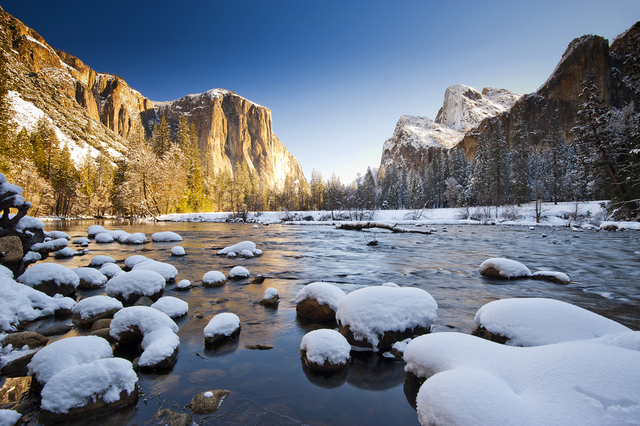Winter in Yosemite offers majestic beauty without the crowds

Yosemite National Park celebrates its 125th anniversary this year, although its status as an American treasure was established a quarter-century before President Benjamin Harrison signed the 1890 act creating the nation’s third national park.
In 1864, President Abraham Lincoln signed the Yosemite Grant, preserving California’s Yosemite Valley and the Mariposa Grove of giant sequoias as the first of America’s wild lands worthy of special protection. Thus was born the idea of a national park system.
Yosemite remains one of the United States’ most popular parks, especially in summer and fall, when it is difficult to find parking spots at viewpoints and attractions and campsites and lodgings are reserved month in advance. Yosemite in winter is a different story. In this season, when the park becomes a winter wonderland, the crowds melt away.
Entrance to Yosemite costs $20 per vehicle. Some park roads are closed by snow, such as Tioga Pass Road from the park’s east entrance off U.S. Highway 395 over the Sierra high country. Roads that remain open into Yosemite Valley in winter include Highway 41 from Fresno, Highway 120 from Manteca, Highway 140 from Merced, and Badger Pass Road as far as the ski area. The road to the Hetch Hetchy area is open from 8 a.m. to 5 p.m. Chains may be required on roads kept open and plowed. When planning a winter trip to Yosemite, check weather and road conditions by calling 209-372-0200.
Many park facilities remain open through the winter, although some campgrounds and at least one of the lodges close with the first big snowfall, reopening in spring. The motel-style Yosemite Falls Lodge and the grand old Ahwahnee Hotel welcome winter guests. Call or go online for reservations.
A gem among national park hotels, the Ahwahnee was built in 1927 of native stone. The national landmark hosts winter wine and food events, including the annual Bracebridge Dinner, a nearly 90-year-old tradition. The event is a 17th-century-style holiday feast with seasonal music and costumed entertainment. Many of the performers are from the San Francisco Opera. For eight nights in December, the Ahwahnee’s grand dining room is turned into a rich squire’s hall where a seven-course meal is served to formally attired guests. Only a few hundred people can participate each year, so when tickets go on sale early in January, those interested should make arrangements for the December event.
Winter visitors can find parking inside the park and use the shuttle transit system to reach facilities within Yosemite Valley. The heated buses run from early morning until evening. They follow a scenic route past many of the park’s iconic natural features, such as Half Dome, El Capitan and several spectacular waterfalls. Winter visitors actually have an advantage over late summer and fall visitors, for beautiful Yosemite Falls, which is fed entirely by snowmelt and rainfall, usually dries up in August, returning only after enough rain or snow falls.
The shuttle stops include several trailheads to points of interest that attract visitors all year, such as short routes to views of cliffs and falls. Hikers should wear layered winter sports gear, coverings for head and hands and boots for warmth with heavy treads for traction. Other winter sports activities include ice skating at a rink at Curry Village in Yosemite Valley, downhill skiing at Badger Pass Ski Area, and cross-country skiing or snowshoeing on old logging roads or in open meadows.
Visitors in any season enjoy the Yosemite Visitor Center and bookstore, open 9 a.m. to 5 p.m. Two fine films, one by Ken Burns, are shown alternately each half-hour in the theater behind the visitor center. Next door, the Yosemite Museum outlines park history, including native cultures. A current art exhibit showcases 50 works by participants in the park’s artists-in-residence program. The nearby Ansel Adams Gallery features photographic works that helped promote Yosemite.
Margo Bartlett Pesek’s Trip of the Week column appears on Sundays.